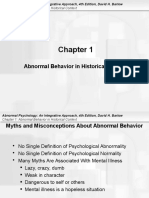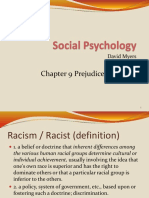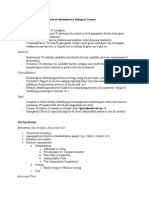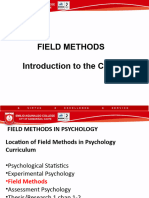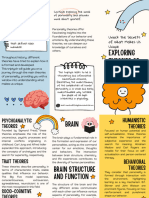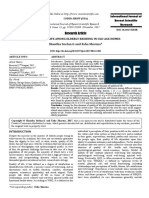0 ratings0% found this document useful (0 votes)
315 viewsPsychodynamic Theories of Personality
Psychodynamic Theories of Personality
Uploaded by
Javier Tracy AnneThis document provides information on Freud's psychodynamic theory of personality development. It discusses Freud's view that personality is formed through stages of psychosexual development centered around different erogenous zones. It also outlines Freud's structural model of the mind consisting of the id, ego, and superego. Various defense mechanisms are defined that the ego uses to resolve conflicts between the id and superego, such as repression, projection, and sublimation. Jungian theory is also briefly mentioned as an alternative psychodynamic approach.
Copyright:
© All Rights Reserved
Available Formats
Download as PDF, TXT or read online from Scribd
Psychodynamic Theories of Personality
Psychodynamic Theories of Personality
Uploaded by
Javier Tracy Anne0 ratings0% found this document useful (0 votes)
315 views41 pagesThis document provides information on Freud's psychodynamic theory of personality development. It discusses Freud's view that personality is formed through stages of psychosexual development centered around different erogenous zones. It also outlines Freud's structural model of the mind consisting of the id, ego, and superego. Various defense mechanisms are defined that the ego uses to resolve conflicts between the id and superego, such as repression, projection, and sublimation. Jungian theory is also briefly mentioned as an alternative psychodynamic approach.
Original Description:
Freud and his followers
Original Title
Psychodynamic Theories of Personality (1)
Copyright
© © All Rights Reserved
Available Formats
PDF, TXT or read online from Scribd
Share this document
Did you find this document useful?
Is this content inappropriate?
This document provides information on Freud's psychodynamic theory of personality development. It discusses Freud's view that personality is formed through stages of psychosexual development centered around different erogenous zones. It also outlines Freud's structural model of the mind consisting of the id, ego, and superego. Various defense mechanisms are defined that the ego uses to resolve conflicts between the id and superego, such as repression, projection, and sublimation. Jungian theory is also briefly mentioned as an alternative psychodynamic approach.
Copyright:
© All Rights Reserved
Available Formats
Download as PDF, TXT or read online from Scribd
Download as pdf or txt
0 ratings0% found this document useful (0 votes)
315 views41 pagesPsychodynamic Theories of Personality
Psychodynamic Theories of Personality
Uploaded by
Javier Tracy AnneThis document provides information on Freud's psychodynamic theory of personality development. It discusses Freud's view that personality is formed through stages of psychosexual development centered around different erogenous zones. It also outlines Freud's structural model of the mind consisting of the id, ego, and superego. Various defense mechanisms are defined that the ego uses to resolve conflicts between the id and superego, such as repression, projection, and sublimation. Jungian theory is also briefly mentioned as an alternative psychodynamic approach.
Copyright:
© All Rights Reserved
Available Formats
Download as PDF, TXT or read online from Scribd
Download as pdf or txt
You are on page 1of 41
Diokno, Debielyn M.
Fernandez, Zyra Joyce C.
Javier, Tracy Anne M.
Masongsong, Myrabeth B.
Mendoza, Hazel
Reyes, Chiara Marie M.
Zalamea, Jesusa B.
Psychodynamic therapy vs.
Psychoanalysis
Freuds theories were psychoanalytic, whereas the
term psychodynamic refers to both his theories
and those of his followers. Freuds psychoanalysis is
both a theory and a therapy.
Psychodynamic therapy does not include all of the
different analytical techniques and is not
conducted by psychoanalytically trained analysts.
Freud and Psychoanalysis
According to Freud (1925), behaviour is motivated
by internal or psychological forces, and abnormality
is caused by an imbalance in the internal forces that
motivate behaviour.
He believed that mental illness arises from unresolved
conscious conflicts, and these usually occur in early
childhood (e.g. the Oedipus complex).
Freud & Psychoanalysis
Psychodynamic
- Emphasis on unconscious intrapsychic
dynamics, in the form of attachments, conflicts, &
motivations
Unconscious processes within the mind
Belief in the importance of early childhood
Freud & Psychoanalysis
Belief that development occurs in fixed stages
Focus on fantasies and symbolic meanings of events
Unconscious motives, guilty secrets, unspeakable
yearnings, & conflicts between desire & duty
The unconscious reveals itself in art, dreams, jokes,
apparent accidents, & slips of the tongue
Reliance on subjective rather than objective methods
The Structure of Personality
3 major systems
Any action we take
or problem we have,
results from the
interaction & degree
of balance among
these systems.
ID
Pleasure principle"
Operates according to the pleasure principle:
Present at birth
Primitive and unconscious part of personality
Reservoir of unconscious psychic energy & the
motives to avoid pain & obtain pleasure
Libido sexual energy
Fights with the Superego
Life or sexual instinct
Death or aggressive instinct
Superego
Moral Principle
Moral ideals and conscience
Judges the activities of the id
Develops around 5/6 years old.
Child internalises moral of society
Fights with the ID
Ego
Reality Principle
Operates according to the reality principle:
Mediates between id and superego
Represents reason & good sense
Summary of Freuds Model of the Mind
Defense Mechanism
What is defense mechanism?
Defense Mechanisms protects our conscious self
from the anxiety produced by the unconscious
intra-psychic conflict if this is unsuccessful, the
anxiety may reveal itself through clinical disorders
e.g. Phobias, anxiety disorders.
Defense Mechanism
If a person feels anxious or threatened when
the wishes of the Id conflict with social roles,
the ego has weapons to relieve the tension.
Defense mechanisms deny or distort reality
but also protect us from conflict & anxiety
[Repression]
This was the first defense mechanism that Freud
discovered, and arguably the most important.
It is an unconscious mechanism employed by the ego
to keep disturbing or threatening thoughts from
becoming conscious.
Thoughts that are often repressed are those that
would result in feelings of guilt from the superego. For
example, in the Oedipus complex, aggressive
thoughts about the same sex parents are repressed.
This is not a very successful defense in the long term
since it involves forcing disturbing wishes, ideas or
memories into the unconscious, where, although
hidden, they will create anxiety.
[Projection]
This involves individuals attributing their own
thoughts, feeling and motives to another person.
Thoughts most commonly projected onto another
are the ones that would cause guilt such as
aggressive and sexual fantasies or thoughts.
For instance, you might hate someone, but your
superego tells you that such hatred is
unacceptable. You can 'solve' the problem by
believing that they hate you.
[Displacement]
Displacement is the redirection of an impulse
(usually aggression) onto a powerless substitute
target.
The target can be a person or an object that can
serve as a symbolic substitute. Someone who feels
uncomfortable with their sexual desire for a real
person may substitute a fetish. Someone who is
frustrated by his or her superiors may go home and
kick the dog, beat up a family member, or engage
in cross-burnings.
[Sublimation]
This is similar to displacement, but takes place when
we manage to displace our emotions into a
constructive rather than destructive activity. This
might for example be artistic. Many great artists
and musicians have had unhappy lives and have
used the medium of art of music to express
themselves. Sport is another example of putting our
emotions (e.g. aggression) into something
constructive.
[Reaction Formation]
This is where a person goes beyond denial and
behaves in the opposite way to which he or she thinks
or feels. By using the reaction formation the id is
satisfied while keeping the ego in ignorance of the
true motives. Conscious feelings are the opposite of
the unconscious. Love - hate. Shame - disgust and
moralizing are reaction formation against sexuality.
Usually a reaction formation is marked by showiness
and compulsiveness. For example, Anal fixation
usually leads to meanness, but occasionally a person
will react against this (unconsciously) leading to over-
generosity.
[Regression]
This is a movement back in psychological time
when one is faced with stress.
When we are troubled or frightened, our behaviors
often become more childish or primitive. A child
may begin to suck their thumb again or wet the
bed when they need to spend some time in the
hospital. Teenagers may giggle uncontrollably
when introduced into a social situation involving the
opposite sex.
[Denial]
Denial involves blocking external events from
awareness.
If some situation is just too much to handle, the
person just refuses to experience it.
As you might imagine, this is a primitive and
dangerous defense - no one disregards reality and
gets away with it for long!
It can operate by itself or, more commonly, in
combination with other, more subtle mechanisms
that support it. For example, smokers may refuse to
admit to themselves that smoking is bad for their
health.
The Development of Personality
Freud believed that children goes through a series
of stages where the instinctive energy of the ID
looks for gratification from different areas of the
body erogenous zones.
If a child is under or over gratified at any stage the
child may become fixated and this could affect
their adult behaviour.
Stage 1: Oral Stage
Birth to 18 months
Occurs during the first year of life when
babies experience the world through their
mouths
Adults seek oral gratification by smoking,
overeating, nail biting, or chewing on pens
Stage 2: Anal Stage
18 months to 3 years
When toilet training & control of bodily
wastes are the key issues.
May become anal retentive holding
everything in, obsessive about neatness &
cleanliness or anal expulsive messy &
disorganized.
Stage 3: Phallic (Oedipal)
18 months to 4/5 years
Most important to the
formation of a person.
Child unconsciously
wishes to possess the
parent of the other sex
& to get rid of the
parent of the same sex
Oedipus Complex
Freud believed that
during the oedipal stage, little
boys fantasize about marrying
their mothers and regard their
fathers as rivals.
Stage 3: Phallic (Oedipal)
Boys are discovering the pleasure & pride of
having a penis, seeing a girl he gets worried &
starts to identify with his father
Girls dont have the motivation to give up the
oedipal feelings leading to penis envy
By 5 or 6 personality is fundamentally formed
Unconscious conflicts with parents, unresolved
fixating, guilt & attitudes towards the same &
opposite sex will continue to replay themselves
throughout life
Stage 4: Latency Stage
4/5 years to adolescence
No further psychosexual development takes
place during this stage (latent means
hidden). The libido is dormant. Freud thought
that most sexual impulses are repressed during
the latent stage and sexual energy can be
sublimated (re: defense mechanisms) towards
school work, hobbies and friendships.
Much of the child's energy is channeled into
developing new skills and acquiring new
knowledge and play becomes largely confined
to other children of the same gender.
Stage 5: Genital Stage
Adolescence
It is a time of adolescent sexual experimentation,
the successful resolution of which is settling down
in a loving one-to-one relationship with another
person in our 20's. Sexual instinct is directed to
heterosexual pleasure, rather than self pleasure
like during the phallic stage.
For Freud, the proper outlet of the sexual instinct
in adults was through heterosexual
intercourse. Fixation and conflict may prevent
this with the consequence that sexual perversions
may develop.
Other Psychodynamic
Approaches
Jungian Theory
Carl Jung
In 1912 while on a lecture tour of America Jung publicly
criticized Freuds theory of the Oedipus complex and his
emphasis on infantile sexuality. The following year this led
to an irrevocable split between them and Jung went on to
develop his own version of psychoanalytic theory.
Most of Jung's assumptions of his analytical psychology
reflect his theoretical differences with Freud. For example,
while Jung agreed with Freud that a persons past
and childhood experiences determined future behavior,
he also believed that we are shaped by our future
(aspirations) too.
[Archetypes]
Archetypes (Jung, 1947) are images and
thoughts which have universal meanings across
cultures which may show up I dreams, literature,
art or religion.
Jung believes symbols from different cultures are
often very similar because they have emerged
from archetypes shared by the whole human
race. For Jung, our primitive past becomes the
basis of the human psyche, directing and
influencing present behavior. Jung claimed to
identify a large number of archetypes but paid
special attention to four.
[persona]
The persona (or mask) is the outward face we
present to the world. It conceals our real self and
Jung describes it as the conformity archetype.
This is the public face or role a person presents to
others as someone different to who we really are
(like an actor).
[anima/animus]
The anima/animus is the mirror image of our
biological sex, that is, the unconscious feminine side
in males and the masculine tendencies in women.
Each sex manifests attitudes and behavior of the
other by virtue of centuries of living together.
The psyche of a woman contains masculine
aspects (the animus archetype) and the psyche of
a man contains feminine aspects (the anima
archetype).
[shadow]
This is the animal side of our personality (like
the id in Freud). It is the source of both our
creative and destructive energies. In line with
evolutionary theory it may be that Jungs
archetypes reflect predispositions that once
had survival value.
[self]
Finally there is the self which provides a sense of
unity in experience.
For Jung the ultimate aim of every individual is to
achieve a state of selfhood (similar to self-
actualisation) and in this respect Jung (like Erikson) is
moving in the direction of a more humanist
orientation.
Adlerian Theory
Alfred Adler was the first to explore and
develop a comprehensive social theory of the
psychodynamic person. He founded a school
of psychology called individual psychology,
which focuses on our drive to compensate for
feelings of inferiority.
Inferiority Complex - which describes a
persons feelings that they lack worth and
dont measure up to the standards of others
or of society.
Adlerian Theory
He eventually came to call this motivating force
the striving for perfection, a term which
encapsulates the desire we all have to fulfill our
potential, to realize our idealsa process strikingly
similar to the more popular idea of self-
actualization.
Striving for Success or Superiority
Adler called the single dynamic force striving for
superiority. In his nal theory, however, he limited
striving for superiority to those people who strive for
personal superiority over others and introduced the
term striving for success to describe actions of
people who are motivated by highly developed
social interest (Adler, 1956). Regardless of the
motivation for striving, each individual is guided by
a nal goal.
Safeguarding Tendencies
Adler believed that people create patterns of behavior
to protect their exaggerated sense of self-esteem
against public disgrace. These protective devices,
called safeguarding tendencies, enable people to hide
their inated self-image and to maintain their current
style of life.
Freudian defense mechanisms operate unconsciously to
protect the ego against anxiety, whereas Adlerian
safeguarding tendencies are largely conscious and
shield a persons fragile self-esteem from public
disgrace. Also, Freuds defense mechanisms are
common to everyone, but Adler (1956) discussed
safeguarding tendencies only with reference to the
construction of neurotic symptoms
Safeguarding Tendencies
Excuses
The most common of the safeguarding tendencies
are excuses, which are typically expressed in the
Yes, but or If only format.
In the Yes, but excuse, people rst state what they
claim they would like to dosomething that sounds
good to others then they follow with an excuse.
A woman might say, Yes, I would like to go to
college, but my children demand too much of my
attention. An executive explains, Yes, I agree with
your proposal, but company policy will not allow it.
Safeguarding Tendencies
Aggression
Adler (1956) held that some people use
aggression to safeguard their exaggerated
superiority complex, that is, to protect their fragile
self-esteem. Safeguarding through aggression
may take the form of depreciation, accusation,
or self-accusation.
Depreciation is the tendency to undervalue other
peoples achievements and to overvalue ones own
Accusation, the second form of an aggressive
safeguarding device, is the tendency to blame others
for ones failures and to seek revenge, thereby
safeguarding ones own tenuous self-esteem.
Self-accusation is marked by self torture and guilt.
Safeguarding Tendencies
Withdrawal
Personality development can be halted when
people run away from difculties. Adler
referred to this tendency as withdrawal, or
safeguarding through distance.
Moving backward
Standing Still
Hesitating
Constructing Obstacles
Adlerian therapy
uses birth order, early
recollections, and dreams
to foster courage, self-
esteem, and social
interest.
You might also like
- Theories of Personality OutlineDocument53 pagesTheories of Personality OutlineKirsten Antonette Atillo95% (20)
- Game of Thrones Theme For Strings PDFDocument6 pagesGame of Thrones Theme For Strings PDFRuth Harvey100% (4)
- Summary of Psychodynamic TheoriesDocument3 pagesSummary of Psychodynamic TheoriesPatty Rivera50% (2)
- Psychoanalytic TheoryDocument23 pagesPsychoanalytic TheoryLydia Mae Velarde Pulgo100% (1)
- Psychoanalytic Theory - HandoutDocument8 pagesPsychoanalytic Theory - Handoutnika_aya100% (1)
- Cognitive Psychology ReviewerDocument8 pagesCognitive Psychology ReviewerAndura, Ramil T.No ratings yet
- Unit 4 - Sensation and Perception Lecture NotesDocument134 pagesUnit 4 - Sensation and Perception Lecture NotesFallon Wall80% (5)
- Psychoanalytic Theory - FreudDocument59 pagesPsychoanalytic Theory - FreudSatchit Prasun Mandal100% (2)
- Psychodynamic TheoryDocument38 pagesPsychodynamic TheoryMubashir QureshiNo ratings yet
- Theories of PersonalityDocument71 pagesTheories of PersonalityCarl Anthony De Leon CalilungNo ratings yet
- Erik Erikson ReportDocument31 pagesErik Erikson ReportJohn Russell MoralesNo ratings yet
- Social Psychology MidtermDocument11 pagesSocial Psychology MidtermRamos EynnaNo ratings yet
- Presentation On Psychodynamic ModelDocument33 pagesPresentation On Psychodynamic ModelMuhammad Asghar100% (1)
- Abnormal Chapter 1Document23 pagesAbnormal Chapter 1EsraRamosNo ratings yet
- Ethics of Psychological AssessmentDocument31 pagesEthics of Psychological AssessmentAhmad Irtaza AdilNo ratings yet
- Karen HorneyDocument9 pagesKaren HorneyNeajNo ratings yet
- Carl RogersDocument18 pagesCarl RogersSymon CarpisoNo ratings yet
- Existential Therapy - HandoutDocument4 pagesExistential Therapy - HandoutJohn Lexter Rosales100% (1)
- Defense Mechanism, Psychological Perspective and Fields of PsychologyDocument46 pagesDefense Mechanism, Psychological Perspective and Fields of PsychologyVince DulayNo ratings yet
- Theories of PersonalityDocument12 pagesTheories of PersonalityFarah XuxaNo ratings yet
- Theories of Personality NotesDocument105 pagesTheories of Personality Noteslinny340088% (8)
- RGO Theories of Personality Enhanced For 2017Document177 pagesRGO Theories of Personality Enhanced For 2017Anonymous okusLz100% (1)
- Field Methods in PsychologyDocument19 pagesField Methods in PsychologyHanny OlasoNo ratings yet
- Chapter 9 Prejudice: David Myers 11eDocument35 pagesChapter 9 Prejudice: David Myers 11eiya calubNo ratings yet
- The Referral Question - Purpose of Assessment by Setting or ContextDocument3 pagesThe Referral Question - Purpose of Assessment by Setting or ContextNancy Fernandez100% (1)
- Person - Centered TheoryDocument72 pagesPerson - Centered TheoryKatox RafalNo ratings yet
- Theory of PersonalityDocument33 pagesTheory of PersonalityLuthviana Azizah100% (1)
- 1 IntroductionDocument27 pages1 IntroductionKEITH ASHLEY BATITISNo ratings yet
- Developmental PsychologyDocument61 pagesDevelopmental PsychologyHINOishi100% (1)
- CH 8 Developmental PsychologyDocument93 pagesCH 8 Developmental PsychologyFyna BobNo ratings yet
- Harry Stack SullivanDocument4 pagesHarry Stack SullivanMichal Gail100% (2)
- Personality - FreudDocument3 pagesPersonality - FreudAyse Kerim100% (4)
- Abnormal Psychology V2Document343 pagesAbnormal Psychology V2Bianca Dennise Villar Guingab100% (2)
- Prepared By: Marc Eric S. Reyes, PHD, RP, RPMDocument26 pagesPrepared By: Marc Eric S. Reyes, PHD, RP, RPMTiffany SyNo ratings yet
- 6 - Horney - Psychoanalytic Social TheoryDocument3 pages6 - Horney - Psychoanalytic Social TheorystephanieNo ratings yet
- Gender Dysphoria: by Ahmad YadakDocument24 pagesGender Dysphoria: by Ahmad YadakAbdulrahman AlsayyedNo ratings yet
- Helping Behavior - PDFDocument4 pagesHelping Behavior - PDFAngeetha KrishnanNo ratings yet
- Obsessive Compulsive Related Disorders: PSYC 340Document21 pagesObsessive Compulsive Related Disorders: PSYC 340Sana FatimaNo ratings yet
- Feist Theories of Personality Chapter 2Document4 pagesFeist Theories of Personality Chapter 2Rashia LubuguinNo ratings yet
- Freud's Stages of Psychosexual DevelopmentDocument27 pagesFreud's Stages of Psychosexual DevelopmentHaidEn Lios100% (3)
- Theories of Personality ScribblesDocument21 pagesTheories of Personality ScribblesNeil Isaac PerezNo ratings yet
- Top TocDocument3 pagesTop TocCnfsr Kayce100% (1)
- Kring Abnormal Psychology Chapter 1 Introduction NotesDocument7 pagesKring Abnormal Psychology Chapter 1 Introduction NotesAnn Ross FernandezNo ratings yet
- (Summary) Theories of PersonalityDocument80 pages(Summary) Theories of PersonalityBrndn GreenNo ratings yet
- Developmental Psychology Chapter OneDocument34 pagesDevelopmental Psychology Chapter OneSalih AnwarNo ratings yet
- Developmental TheoryDocument9 pagesDevelopmental TheoryLei ぱんがにばんNo ratings yet
- PRELIM CHAPTER 1 Psychological Testing and AssessmentDocument80 pagesPRELIM CHAPTER 1 Psychological Testing and AssessmentAndrei BagaoNo ratings yet
- Top Reviewer Theories of Personality by Feist and Feist CompressDocument70 pagesTop Reviewer Theories of Personality by Feist and Feist CompressFrances Rein TacusalmeNo ratings yet
- 01 Abnormal PsychologyDocument35 pages01 Abnormal PsychologyHurjae Soriano Lubag100% (1)
- Theories of Personality NOTESDocument17 pagesTheories of Personality NOTEStaylor alison swiftNo ratings yet
- Psychoanalysis Theory PDFDocument45 pagesPsychoanalysis Theory PDFTeacher Jelo Matt CamoronganNo ratings yet
- Social Psychology (Chapter 6) Conformity and ObedienceDocument5 pagesSocial Psychology (Chapter 6) Conformity and ObedienceAdrian Esico Guleng100% (1)
- Carl RogersDocument16 pagesCarl RogersMary Ivie ArlanNo ratings yet
- Chapter 3Document69 pagesChapter 3LisetteNo ratings yet
- Rogers' Humanist Theory: Nomar J. MercinesDocument40 pagesRogers' Humanist Theory: Nomar J. MercinesNomar MercinesNo ratings yet
- Theories of Development: Early Childhood)Document3 pagesTheories of Development: Early Childhood)Sofia Marie Galendez100% (1)
- Lab Manual Experimental Psychology Second PartDocument28 pagesLab Manual Experimental Psychology Second PartFrances Thom DelacruzNo ratings yet
- Theories of Personality and PsychopathologyDocument12 pagesTheories of Personality and Psychopathologysarguss14100% (9)
- Trait Personality TheoryDocument26 pagesTrait Personality TheoryVahmi Brian Owen D'sullivansevenfoldimerzNo ratings yet
- Exploring Theories of PersonalityDocument2 pagesExploring Theories of Personalityidries08romero23No ratings yet
- CH 2 Part 2 (PTR)Document40 pagesCH 2 Part 2 (PTR)Trisha V ReddyNo ratings yet
- Cognitive Behavioral Therapy: Group 2 Agdon Cueto Dimayuga Felasol Garcia Litan QuiambaoDocument17 pagesCognitive Behavioral Therapy: Group 2 Agdon Cueto Dimayuga Felasol Garcia Litan QuiambaoJavier Tracy Anne100% (1)
- Cognitive Behavioral Therapy: Group 2 Agdon Cueto Dimayuga Felasol Garcia Litan QuiambaoDocument17 pagesCognitive Behavioral Therapy: Group 2 Agdon Cueto Dimayuga Felasol Garcia Litan QuiambaoJavier Tracy Anne100% (1)
- Overview of Clinical PsychologyDocument15 pagesOverview of Clinical PsychologyJavier Tracy AnneNo ratings yet
- Therapeutic ProcessDocument24 pagesTherapeutic ProcessJavier Tracy Anne0% (1)
- This Course Is Intended To Provide Information For Those Considering A Career On Clinical PsychologyDocument3 pagesThis Course Is Intended To Provide Information For Those Considering A Career On Clinical PsychologyJavier Tracy AnneNo ratings yet
- Violence in Moroccan SchoolDocument15 pagesViolence in Moroccan SchoolNizar KhazaneNo ratings yet
- Resume Gokulakrishnan Thanigachalam 12yrs ExperienceDocument2 pagesResume Gokulakrishnan Thanigachalam 12yrs Experiencegokul1982No ratings yet
- 06 Cost Volume Profit RelationshipsDocument74 pages06 Cost Volume Profit RelationshipsGxjn LxmnNo ratings yet
- Malcolm X AutobiographyDocument9 pagesMalcolm X AutobiographymilluslandyNo ratings yet
- GFF - Elven Jesters v2.50Document2 pagesGFF - Elven Jesters v2.50Agustin Estudillo PerezNo ratings yet
- Access2013 T02 PPTDocument43 pagesAccess2013 T02 PPTArshad AyubNo ratings yet
- Gamboa v. Teves, 652 SCRA 690Document62 pagesGamboa v. Teves, 652 SCRA 690d-fbuser-49417072No ratings yet
- Counter-Affidavit: Republic of The Philippines) City of Davao) S.S. X - XDocument3 pagesCounter-Affidavit: Republic of The Philippines) City of Davao) S.S. X - XPaulo VillarinNo ratings yet
- Review Questions: Written/Composed By: - SHAHZAD IFTIKHAR Contact # 0313-5665666 WebsiteDocument6 pagesReview Questions: Written/Composed By: - SHAHZAD IFTIKHAR Contact # 0313-5665666 WebsitesohailNo ratings yet
- 2024 Cambridge Exams Center Number: QA009 Provisional TimetableDocument2 pages2024 Cambridge Exams Center Number: QA009 Provisional Timetableomarkbkb2007suiNo ratings yet
- Report On Industrial Visit: Visited Professor Visited StudentsDocument10 pagesReport On Industrial Visit: Visited Professor Visited StudentsRishabh MishraNo ratings yet
- HCL Industrial Training ReportDocument40 pagesHCL Industrial Training ReportBirjesh KumarNo ratings yet
- THE DARK SIDE OF Dialectics - Files PDFDocument32 pagesTHE DARK SIDE OF Dialectics - Files PDFJohn LiNo ratings yet
- Contract CostsDocument4 pagesContract CostsPhilip Jhon BayoNo ratings yet
- Donaldson, Bess Allen (1937) - Koran As MagicDocument12 pagesDonaldson, Bess Allen (1937) - Koran As MagicAndreaNo ratings yet
- Assumptions MappingDocument1 pageAssumptions MappingLuis Erazo GalloNo ratings yet
- Name - Date - ClassDocument1 pageName - Date - ClassToñi Varo GarridoNo ratings yet
- vm9 FiringchartDocument1 pagevm9 Firingchartjohn.pobligonNo ratings yet
- Biogeography - I - Study NotesDocument17 pagesBiogeography - I - Study Notessvtiwari58No ratings yet
- Sip Report..Document49 pagesSip Report..Zulquarnain100% (2)
- MS1200NF Mineral Sorting For Rare MetalDocument2 pagesMS1200NF Mineral Sorting For Rare MetalnataNo ratings yet
- Reported Questions - Board GameDocument1 pageReported Questions - Board GameRebeca GutiérrezNo ratings yet
- Introduction To CAM Lesson 1Document9 pagesIntroduction To CAM Lesson 1itsshri25No ratings yet
- Vocabulary 1. Where Do You Usually Find These Items? Choose The Correct PlacesDocument8 pagesVocabulary 1. Where Do You Usually Find These Items? Choose The Correct PlacesXabierNo ratings yet
- Gujarat Elevator ManufacturerDocument7 pagesGujarat Elevator ManufacturerHemant Joshi100% (1)
- Keyword Tool Export - Keyword Suggestions - Python DeveloperDocument13 pagesKeyword Tool Export - Keyword Suggestions - Python DeveloperShiva BkNo ratings yet
- Mercedes RapportDocument137 pagesMercedes RapportFatima Ezzahra El MasbahiNo ratings yet
- Research Article: Shantha Seelan.G and Esha SharmaDocument4 pagesResearch Article: Shantha Seelan.G and Esha Sharmagunesh1No ratings yet
- Semi Finals (Ethics)Document4 pagesSemi Finals (Ethics)Alexa VegaNo ratings yet













